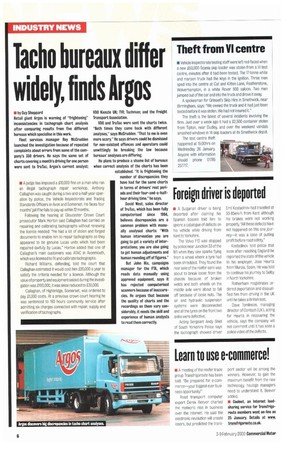widely, finds Argos
Page 8

If you've noticed an error in this article please click here to report it so we can fix it.
• by Guy Sheppard Retail giant Argos is warning of "frightening" inconsistencies in tachograph chart analysis after comparing results from five different bureaux which specialise in this work, Fleet services manager Roy McCrudden launched the investigation because of repeated complaints about errors from some of the company's 350 drivers. He says the same set of charts covering a month's driving for one person were sent to TruTac, Argos's current analyst:
VDO Kienzle UK; TI/I: Tachman; and the Freight Transport Association.
VDO and TruTac were sent the charts twice. "Both times they came back with different analyses," says McCrudden. "That to me is even more scary." He says drivers could be dismissed for non-existent offences and operators could unwittingly be breaking the law because bureaux' analyses are differing.
He plans to produce a shame list of bureaux when correct analysis of the charts has been
established. "It is frightening the number of discrepancies they have had for the same charts in terms of drivers' rest periods and their four-and-a-halfhour driving time:' he says.
David West, sales director of TruTac, which has been fully computerised since 1994, believes discrepancies are a common problem with manually analysed charts: -With human intervention you are going to get a variety of interpretations; you are also going to get human adjustments and human rounding off of figures."
But John His, campaigns manager for the FTA, which reads data manually using approved equipment, says it has rejected computerised scanners because of inaccuracies. He argues that because the quality of charts and the recordings on them vary considerably, it needs the skill and experience of human analysts to read them correctly.




































































































